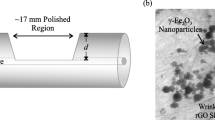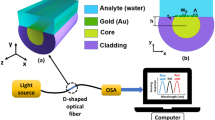Abstract
High precision and high throughput detection of heavy metal ions is essential for water quality monitoring and assessment. Herein, we propose a plasmonic & electrochemical dual-mode fiber sensing probe for label-free and real-time detection of multiple ions (Pb2+ and Cu2+ as examples). This sensor comprises a multimode fiber-single mode fiber reflection probe, the outer surface of which is coated with a gold nanofilm to excite the surface plasmon resonance (SPR) optically and simultaneously serves as an electrochemical working electrode. In traditional electrochemical detection, the enrichment of ions cannot be detected in real-time. However, by utilizing the plasmonic & electrochemical dual-mode detection method, various kinds of metal ions can be deposited onto the gold nanofilm and selectively oxidized during forward potential scanning, and the entire electrochemical process can be monitored by SPR measurement. We experimentally demonstrate that the sensor can simultaneously detect Pb2+ and Cu2+ in a mixed solution in real-time, providing a linear response over the ion concentration range from 10−12 to 10−7 M and offering an excellent detection limit (1.69×10−14–5.49×10−13 M). The proposed dual-mode fiber sensor has the benefits of remote sensing, compact footprint, and cost-effectiveness and shows excellent potential for water quality risk management in difficult-to-reach environments.
Similar content being viewed by others
References
Mourya A, Sinha S K, Mazumdar B. Glassy carbon electrode modified with blast furnace slag for electrochemical investigation of Cu2+ and Pb2+ metal ions. MicroChem J, 2019, 147: 707–716
Valko M, Jomova K, Rhodes C J, et al. Redox- and non-redox-metal-induced formation of free radicals and their role in human disease. Arch Toxicol, 2016, 90: 1–37
Zhang M, Sun X, Xu J L. Heavy metal pollution in the East China Sea: a review. Mar Pollution Bull, 2020, 159: 111473
Vardhan K H, Kumar P S, Panda R C. A review on heavy metal pollution, toxicity and remedial measures: current trends and future perspectives. J Mol Liquids, 2019, 290: 111197
Liu X L, Wang Y Z, Song Y J. Visually multiplexed quantitation of heavy metal ions in water using volumetric bar-chart chip. Biosens Bioelectron, 2018, 117: 644–650
Ghaedi M, Fathi M R, Shokrollahi A, et al. Highly selective and sensitive preconcentration of mercury ion and determination by cold vapor atomic absorption spectroscopy. Anal Lett, 2006, 39: 1171–1185
Li W W, Liu J, Sun K, et al. Highly fluorescent water soluble CdxZni1−xTe alloyed quantum dots prepared in aqueous solution: one-step synthesis and the alloy effect of Zn. J Mater Chem, 2010, 20: 2133–2138
Rasheed T, Bilal M, Nabeel F, et al. Fluorescent sensor based models for the detection of environmentally-related toxic heavy metals. Sci Total Environ, 2018, 615: 476–485
Kumar M K, Nagendrappa G, Shivanna A M. ICP-AES estimation of a few heavy and toxic metal ions present in water samples collected from the three lakes situated in Bangalore city. Environ Sci Technol, 2016, 15: 549
Karami H, Mousavi M F, Yamini Y, et al. On-line preconcentration and simultaneous determination of heavy metal ions by inductively coupled plasma-atomic emission spectrometry. Anal Chim Acta, 2004, 509: 89–94
Cocherie A, Robert M. Direct measurement of lead isotope ratios in low concentration environmental samples by MC-ICP-MS and multi-ion counting. Chem Geol, 2007, 243: 90–104
Yap S H K, Chien Y H, Tan R, et al. An advanced hand-held microfiber-based sensor for ultrasensitive lead ion detection. ACS Sens, 2018, 3: 2506–2512
Lu M D, Zhou H F, Peng W, et al. Dithiol self-assembled monolayer based electrochemical surface plasmon resonance optical fiber sensor for selective heavy metal ions detection. J Lightwave Technol, 2021, 39: 4034–4040
Hwang J H, Wang X, Zhao D, et al. A novel nanoporous bismuth electrode sensor for in situ heavy metal detection. Electrochim Acta, 2019, 298: 440–448
Lee S, Oh J, Kim D, et al. A sensitive electrochemical sensor using an iron oxide/graphene composite for the simultaneous detection of heavy metal ions. Talanta, 2016, 160: 528–536
Wang L L, Jiang X, Su S, et al. A thiol and magnetic polymer-based electrochemical sensor for on-site simultaneous detection of lead and copper in water. MicroChem J, 2021, 168: 106493
Ge K, Xu Z Y, Guo D, et al. RGB WGM lasing woven in fiber braiding cavity. Sci China Inf Sci, 2022, 65: 182403
Hao Z, Ma Y X, Jiang B Q, et al. Second harmonic generation in a hollow-core fiber filled with GaSe nanosheets. Sci China Inf Sci, 2022, 65: 162403
Huang L J, He Z Y, Fan X Y. Simplified single-end Rayleigh and Brillouin hybrid distributed fiber-optic sensing system. Sci China Inf Sci, 2023, 66: 129404
Yanase Y, Araki A, Suzuki H, et al. Development of an optical fiber SPR sensor for living cell activation. Biosens Bioelectron, 2010, 25: 1244–1247
Shrivastav A M, Usha S P, Gupta B D. Fiber optic profenofos sensor based on surface plasmon resonance technique and molecular imprinting. Biosens Bioelectron, 2016, 79: 150–157
Cai S S, Liu F, Wang R L, et al. Narrow bandwidth fiber-optic spectral combs for renewable hydrogen detection. Sci China Inf Sci, 2020, 63: 222401
Wang R L, Zhang H Z, Liu Q Y, et al. Operando monitoring of ion activities in aqueous batteries with plasmonic fiber-optic sensors. Nat Commun, 2022, 13: 547
Wang F, Zhang Y, Lu M D, et al. Near-infrared band Gold nanoparticles-Au film “hot spot” model based label-free ultratrace lead (II) ions detection via fiber SPR DNAzyme biosensor. Sens Actuat B-Chem, 2021, 337: 129816
Wang S P, Forzani E S, Tao N J. Detection of heavy metal ions in water by high-resolution surface plasmon resonance spectroscopy combined with anodic stripping voltammetry. Anal Chem, 2007, 79: 4427–4432
Wang S P, Huang X P, Shan X N, et al. Electrochemical surface plasmon resonance: basic formalism and experimental validation. Anal Chem, 2010, 82: 935–941
Li N T, Zhang D M, Zhang Q, et al. Combining localized surface plasmon resonance with anodic stripping voltammetry for heavy metal ion detection. Sens Actuat B-Chem, 2016, 231: 349–356
Si Y, Lao J J, Zhang X J, et al. Electrochemical plasmonic fiber-optic sensors for ultra-sensitive heavy metal detection. J Lightwave Technol, 2019, 37: 3495–3502
Zhou S R, Li X J, Zhang J H, et al. Dual-fiber optic bioprobe system for triglyceride detection using surface plasmon resonance sensing and lipase-immobilized magnetic bead hydrolysis. Biosens Bioelectron, 2022, 196: 113723
Chen Z L, Han K L, Zhang Y N. Reflective fiber surface plasmon resonance sensor for high-sensitive mercury ion detection. Appl Sci, 2019, 9: 1480
Hu J Y, Li Z, Zhai C Y, et al. Photo-assisted simultaneous electrochemical detection of multiple heavy metal ions with a metal-free carbon black anchored graphitic carbon nitride sensor. Anal Chim Acta, 2021, 1183: 338951
Peng X L, Ren Z C, Lu C H, et al. Hybrid electrochemical-surface plasmon resonance microfiber sensor for Pb2+ detection. J Lightwave Technol, 2023, 41: 4307–4314
Caucheteur C, Guo T, Liu F, et al. Ultrasensitive plasmonic sensing in air using optical fibre spectral combs. Nat Commun, 2016, 7: 1–8
Liu F, Zhang X J, Li K W, et al. Discrimination of bulk and surface refractive index change in plasmonic sensors with narrow bandwidth resonance combs. ACS Sens, 2021, 6: 3013–3023
Li Z, Zhang H M, Zha Q B, et al. Photo-electrochemical detection of dopamine in human urine and calf serum based on MIL-101 (Cr)/carbon black. Microchim Acta, 2020, 187: 526
Pathak P, Hwang J H, Li R H T, et al. Flexible copper-biopolymer nanocomposite sensors for trace level lead detection in water. Sens Actuat B-Chem, 2021, 344: 130263
Liu L H, Zhang X J, Zhu Q, et al. Ultrasensitive detection of endocrine disruptors via superfine plasmonic spectral combs. Light Sci Appl, 2021, 10: 181
Chiavaioli F, Gouveia C, Jorge P, et al. Towards a uniform metrological assessment of grating-based optical fiber sensors: from refractometers to biosensors. Biosensors, 2017, 7: 23
Acknowledgements
This work was supported in part by National Natural Science Foundation of China (Grant Nos. 62035006, 61975068, 62005101, 61827819), Guangdong Outstanding Scientific Innovation Foundation (Grant No. 2019TX05X383), Program of Marine Economy Development Special Fund under Department of Natural Resources of Guangdong Province (Grant No. GDNRC [2023]23), Local Innovative and Research Teams Project of Guangdong Pearl River Talents Program (Grant No. 2019BT02X105), Research Fund of Guangdong-Hong Kong-Macao Joint Laboratory for Intelligent Micro-Nano Optoelectronic Technology (Grant No. 2020B1212030010), Project of Scientific and Technological Development Plan of Jilin Province (Grant No. 20220508130RC), and Open Fund of Guangdong Provincial Key Laboratory of Optical Fiber Sensing and Communication Technology.
Author information
Authors and Affiliations
Corresponding authors
Rights and permissions
About this article
Cite this article
Peng, X., Yang, Z., Peng, B. et al. In situ plasmonic & electrochemical fiber-optic sensor for multi-metal-ions detection. Sci. China Inf. Sci. 67, 112406 (2024). https://doi.org/10.1007/s11432-023-3746-8
Received:
Revised:
Accepted:
Published:
DOI: https://doi.org/10.1007/s11432-023-3746-8




